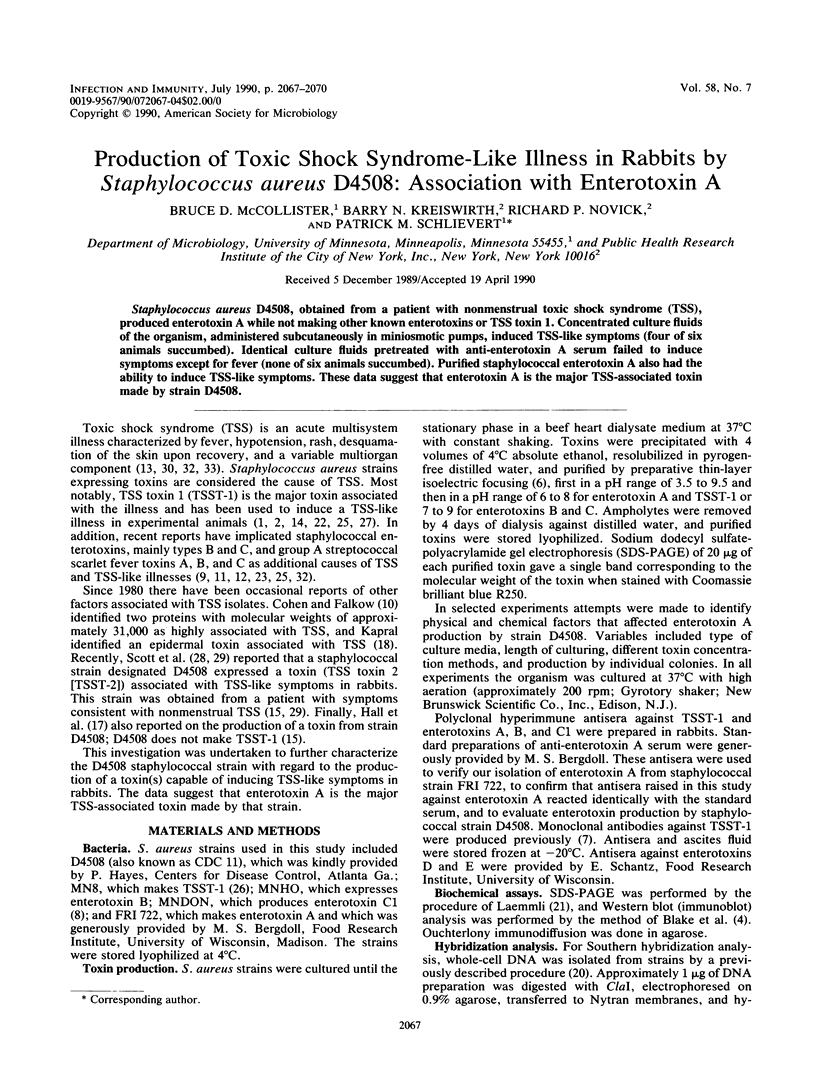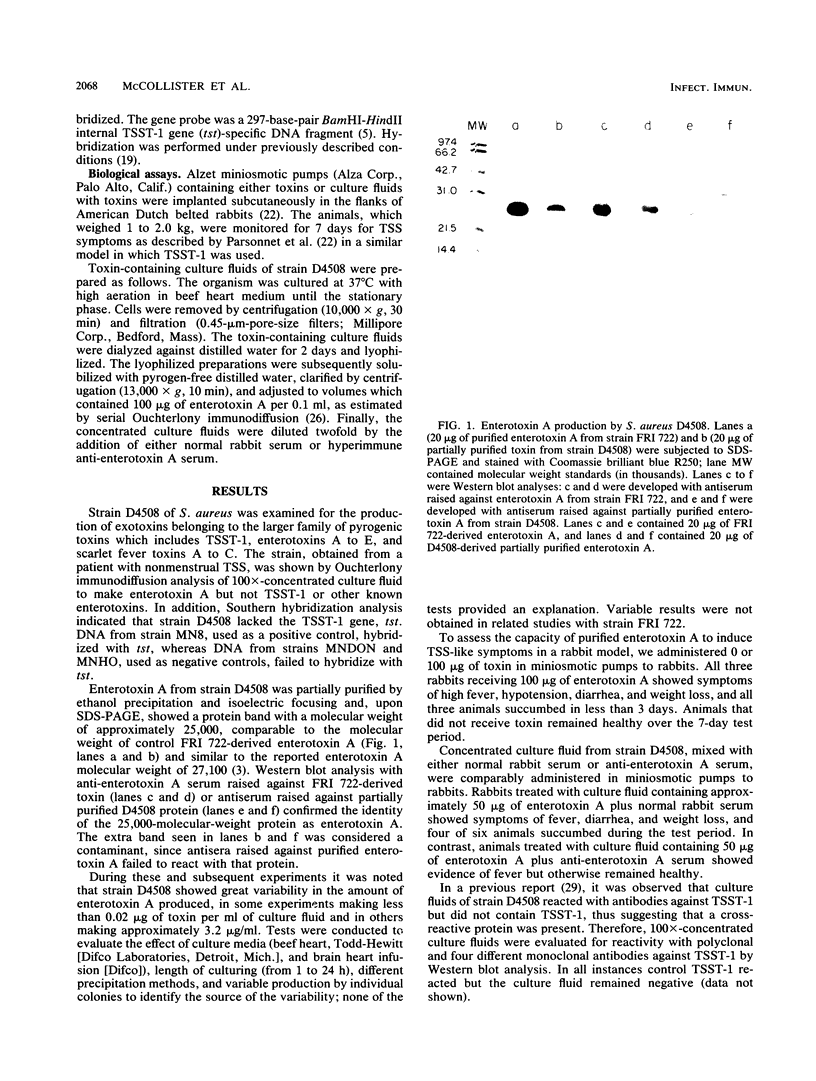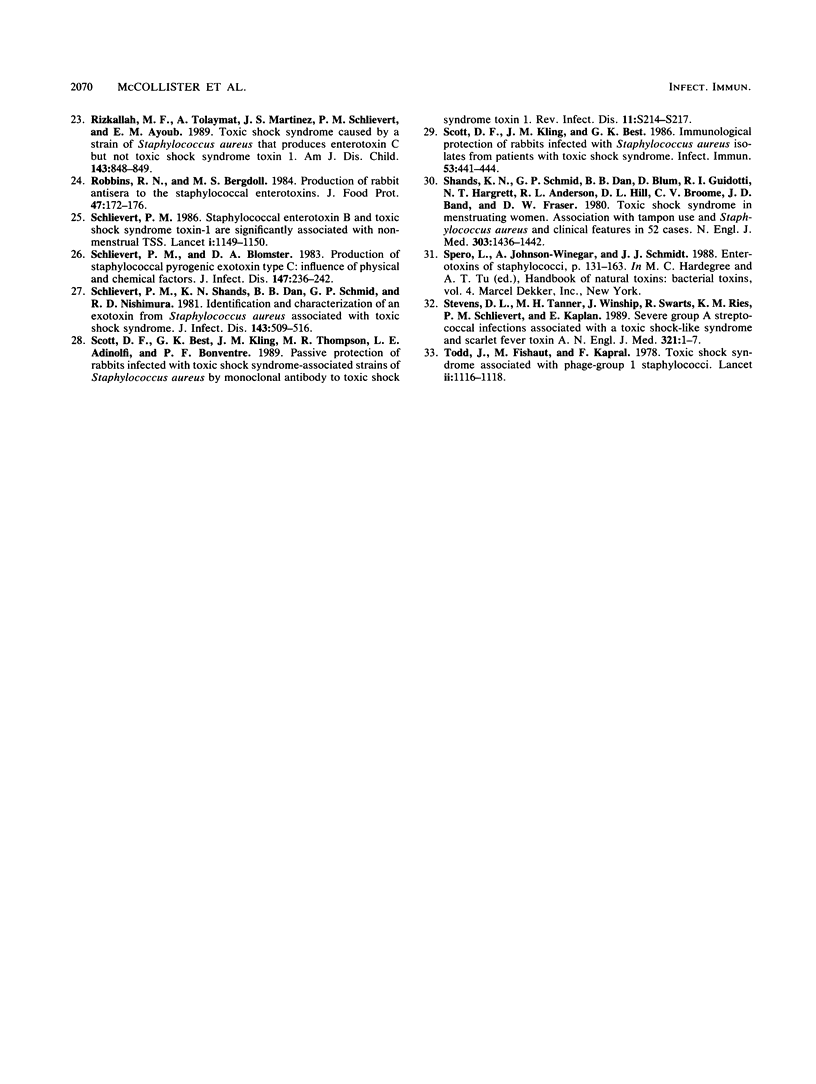Abstract
Staphylococcus aureus D4508, obtained from a patient with nonmenstrual toxic shock syndrome (TSS), produced enterotoxin A while not making other known enterotoxins or TSS toxin 1. Concentrated culture fluids of the organism, administered subcutaneously in miniosmotic pumps, induced TSS-like symptoms (four of six animals succumbed). Identical culture fluids pretreated with anti-enterotoxin A serum failed to induce symptoms except for fever (none of six animals succumbed). Purified staphylococcal enterotoxin A also had the ability to induce TSS-like symptoms. These data suggest that enterotoxin A is the major TSS-associated toxin made by strain D4508.
Full text
PDF



Images in this article
Selected References
These references are in PubMed. This may not be the complete list of references from this article.
- Bergdoll M. S., Crass B. A., Reiser R. F., Robbins R. N., Davis J. P. A new staphylococcal enterotoxin, enterotoxin F, associated with toxic-shock-syndrome Staphylococcus aureus isolates. Lancet. 1981 May 9;1(8228):1017–1021. doi: 10.1016/s0140-6736(81)92186-3. [DOI] [PubMed] [Google Scholar]
- Betley M. J., Mekalanos J. J. Nucleotide sequence of the type A staphylococcal enterotoxin gene. J Bacteriol. 1988 Jan;170(1):34–41. doi: 10.1128/jb.170.1.34-41.1988. [DOI] [PMC free article] [PubMed] [Google Scholar]
- Blake M. S., Johnston K. H., Russell-Jones G. J., Gotschlich E. C. A rapid, sensitive method for detection of alkaline phosphatase-conjugated anti-antibody on Western blots. Anal Biochem. 1984 Jan;136(1):175–179. doi: 10.1016/0003-2697(84)90320-8. [DOI] [PubMed] [Google Scholar]
- Blomster-Hautamaa D. A., Kreiswirth B. N., Kornblum J. S., Novick R. P., Schlievert P. M. The nucleotide and partial amino acid sequence of toxic shock syndrome toxin-1. J Biol Chem. 1986 Nov 25;261(33):15783–15786. [PubMed] [Google Scholar]
- Blomster-Hautamaa D. A., Kreiswirth B. N., Novick R. P., Schlievert P. M. Resolution of highly purified toxic-shock syndrome toxin 1 into two distinct proteins by isoelectric focusing. Biochemistry. 1986 Jan 14;25(1):54–59. doi: 10.1021/bi00349a009. [DOI] [PubMed] [Google Scholar]
- Blomster-Hautamaa D. A., Novick R. P., Schlievert P. M. Localization of biologic functions of toxic shock syndrome toxin-1 by use of monoclonal antibodies and cyanogen bromide-generated toxin fragments. J Immunol. 1986 Dec 1;137(11):3572–3576. [PubMed] [Google Scholar]
- Bohach G. A., Schlievert P. M. Expression of staphylococcal enterotoxin C1 in Escherichia coli. Infect Immun. 1987 Feb;55(2):428–432. doi: 10.1128/iai.55.2.428-432.1987. [DOI] [PMC free article] [PubMed] [Google Scholar]
- Chow A. W., Wittmann B. K., Bartlett K. H., Scheifele D. W. Variant postpartum toxic shock syndrome with probable intrapartum transmission to the neonate. Am J Obstet Gynecol. 1984 Apr 15;148(8):1074–1079. doi: 10.1016/s0002-9378(84)90448-4. [DOI] [PubMed] [Google Scholar]
- Cohen M. L., Falkow S. Protein antigens from Staphylococcus aureus strains associated with toxic-shock syndrome. Science. 1981 Feb 20;211(4484):842–844. doi: 10.1126/science.7466361. [DOI] [PubMed] [Google Scholar]
- Crass B. A., Bergdoll M. S. Involvement of staphylococcal enterotoxins in nonmenstrual toxic shock syndrome. J Clin Microbiol. 1986 Jun;23(6):1138–1139. doi: 10.1128/jcm.23.6.1138-1139.1986. [DOI] [PMC free article] [PubMed] [Google Scholar]
- Crass B. A., Bergdoll M. S. Toxin involvement in toxic shock syndrome. J Infect Dis. 1986 May;153(5):918–926. doi: 10.1093/infdis/153.5.918. [DOI] [PubMed] [Google Scholar]
- Davis J. P., Chesney P. J., Wand P. J., LaVenture M. Toxic-shock syndrome: epidemiologic features, recurrence, risk factors, and prevention. N Engl J Med. 1980 Dec 18;303(25):1429–1435. doi: 10.1056/NEJM198012183032501. [DOI] [PubMed] [Google Scholar]
- Farber B. F., Broome C. V., Hopkins C. C. Fulminant hospital-acquired toxic shock syndrome. Am J Med. 1984 Aug;77(2):331–332. doi: 10.1016/0002-9343(84)90711-3. [DOI] [PubMed] [Google Scholar]
- Garbe P. L., Arko R. J., Reingold A. L., Graves L. M., Hayes P. S., Hightower A. W., Chandler F. W., Broome C. V. Staphylococcus aureus isolates from patients with nonmenstrual toxic shock syndrome. Evidence for additional toxins. JAMA. 1985 May 3;253(17):2538–2542. [PubMed] [Google Scholar]
- Hall W. W., Blander S., Kakani R., Fischetti V. A., Zabriskie J. B. Identification of a new toxin from a strain of Staphylococcus aureus isolated from a patient with nonmenstrual toxic shock syndrome. Rev Infect Dis. 1989 Jan-Feb;11 (Suppl 1):S130–S136. doi: 10.1093/clinids/11.supplement_1.s130. [DOI] [PubMed] [Google Scholar]
- Kapral F. A. Epidermal toxin production by Staphylococcus aureus strains from patients with toxic shock syndrome. Ann Intern Med. 1982 Jun;96(6 Pt 2):972–974. doi: 10.7326/0003-4819-96-6-972. [DOI] [PubMed] [Google Scholar]
- Kreiswirth B. N., Löfdahl S., Betley M. J., O'Reilly M., Schlievert P. M., Bergdoll M. S., Novick R. P. The toxic shock syndrome exotoxin structural gene is not detectably transmitted by a prophage. Nature. 1983 Oct 20;305(5936):709–712. doi: 10.1038/305709a0. [DOI] [PubMed] [Google Scholar]
- Kreiswirth B. N., Schlievert P. M., Novick R. P. Evaluation of coagulase-negative staphylococci for ability to produce toxic shock syndrome toxin 1. J Clin Microbiol. 1987 Oct;25(10):2028–2029. doi: 10.1128/jcm.25.10.2028-2029.1987. [DOI] [PMC free article] [PubMed] [Google Scholar]
- Laemmli U. K. Cleavage of structural proteins during the assembly of the head of bacteriophage T4. Nature. 1970 Aug 15;227(5259):680–685. doi: 10.1038/227680a0. [DOI] [PubMed] [Google Scholar]
- Parsonnet J., Gillis Z. A., Richter A. G., Pier G. B. A rabbit model of toxic shock syndrome that uses a constant, subcutaneous infusion of toxic shock syndrome toxin 1. Infect Immun. 1987 May;55(5):1070–1076. doi: 10.1128/iai.55.5.1070-1076.1987. [DOI] [PMC free article] [PubMed] [Google Scholar]
- Rizkallah M. F., Tolaymat A., Martinez J. S., Schlievert P. M., Ayoub E. M. Toxic shock syndrome caused by a strain of Staphylococcus aureus that produces enterotoxin C but not toxic shock syndrome toxin-1. Am J Dis Child. 1989 Jul;143(7):848–849. doi: 10.1001/archpedi.1989.02150190098031. [DOI] [PubMed] [Google Scholar]
- Schlievert P. M., Blomster D. A. Production of staphylococcal pyrogenic exotoxin type C: influence of physical and chemical factors. J Infect Dis. 1983 Feb;147(2):236–242. doi: 10.1093/infdis/147.2.236. [DOI] [PubMed] [Google Scholar]
- Schlievert P. M., Shands K. N., Dan B. B., Schmid G. P., Nishimura R. D. Identification and characterization of an exotoxin from Staphylococcus aureus associated with toxic-shock syndrome. J Infect Dis. 1981 Apr;143(4):509–516. doi: 10.1093/infdis/143.4.509. [DOI] [PubMed] [Google Scholar]
- Schlievert P. M. Staphylococcal enterotoxin B and toxic-shock syndrome toxin-1 are significantly associated with non-menstrual TSS. Lancet. 1986 May 17;1(8490):1149–1150. doi: 10.1016/s0140-6736(86)91859-3. [DOI] [PubMed] [Google Scholar]
- Scott D. F., Best G. K., Kling J. M., Thompson M. R., Adinolfi L. E., Bonventre P. F. Passive protection of rabbits infected with toxic shock syndrome-associated strains of Staphylococcus aureus by monoclonal antibody to toxic shock syndrome toxin 1. Rev Infect Dis. 1989 Jan-Feb;11 (Suppl 1):S214–S218. doi: 10.1093/clinids/11.supplement_1.s214. [DOI] [PubMed] [Google Scholar]
- Scott D. F., Kling J. M., Best G. K. Immunological protection of rabbits infected with Staphylococcus aureus isolates from patients with toxic shock syndrome. Infect Immun. 1986 Aug;53(2):441–444. doi: 10.1128/iai.53.2.441-444.1986. [DOI] [PMC free article] [PubMed] [Google Scholar]
- Shands K. N., Schmid G. P., Dan B. B., Blum D., Guidotti R. J., Hargrett N. T., Anderson R. L., Hill D. L., Broome C. V., Band J. D. Toxic-shock syndrome in menstruating women: association with tampon use and Staphylococcus aureus and clinical features in 52 cases. N Engl J Med. 1980 Dec 18;303(25):1436–1442. doi: 10.1056/NEJM198012183032502. [DOI] [PubMed] [Google Scholar]
- Stevens D. L., Tanner M. H., Winship J., Swarts R., Ries K. M., Schlievert P. M., Kaplan E. Severe group A streptococcal infections associated with a toxic shock-like syndrome and scarlet fever toxin A. N Engl J Med. 1989 Jul 6;321(1):1–7. doi: 10.1056/NEJM198907063210101. [DOI] [PubMed] [Google Scholar]
- Todd J., Fishaut M., Kapral F., Welch T. Toxic-shock syndrome associated with phage-group-I Staphylococci. Lancet. 1978 Nov 25;2(8100):1116–1118. doi: 10.1016/s0140-6736(78)92274-2. [DOI] [PubMed] [Google Scholar]
- de Azavedo J. C., Arbuthnott J. P. Toxicity of staphylococcal toxic shock syndrome toxin 1 in rabbits. Infect Immun. 1984 Nov;46(2):314–317. doi: 10.1128/iai.46.2.314-317.1984. [DOI] [PMC free article] [PubMed] [Google Scholar]



